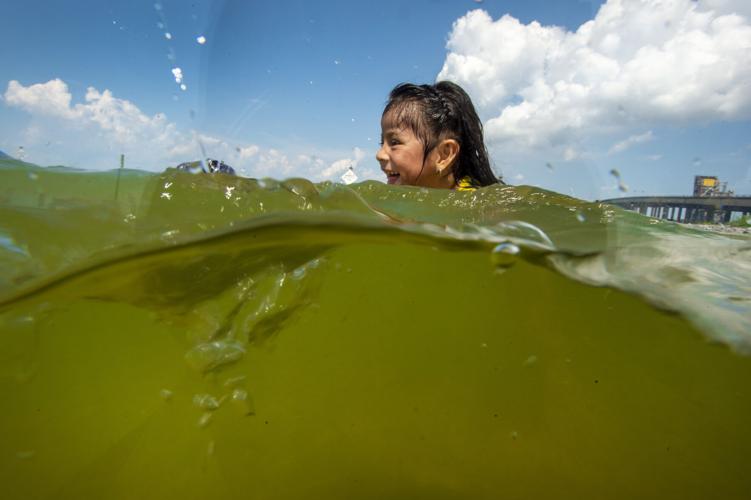If you've noticed a greenish tinge to the water in Lake Pontchartrain while traveling from the northshore this week, you’re not hallucinating.
Satellite data collected by NASA’s National Centers for Coastal Ocean Science identified an explosion of cyanobacteria across much of Lakes Pontchartrain and Maurepas on Sunday and Monday, but also across a number of other lakes and open water areas south of the Mississippi River in late May and early June.

This satellite image above shows the location of cyanobacteria, a possible indicator of the presence of toxic blue-green algae on Sunday, June 4, 2023. The Louisiana Department of Health warned residents to avoid areas where potential harmful algae might be present. However, weekly tests of water by the Pontchartrain Conservancy at different locations in Lake Pontchartrain on Tuesday found no evidence of blue-green algae. (This image was derived from Copernicus Sentinel-3 satellite data from the European Organisation for the Exploitation of Meteorological Satellites (EUMETSAT) and were processed by NOAA's National Centers for Coastal Ocean Science.)
And while the satellite images on their own are not enough to say whether the discolored water is the result of toxic blue-green algae, the Louisiana Department of Health on Tuesday warned residents to avoid those areas.
“While some algae are harmless, certain types can produce toxins that are harmful to humans, animals and the environment,” said a Health Department news release. “Therefore, it is crucial for individuals to be knowledgeable and take necessary precautions when encountering water bodies affected by algae blooms.
“You cannot tell if a bloom is harmful just by looking at it and not all blooms are easy to see, so it is best to use caution and stay away."
Health Department officials said their warning was partly based on information provided them by the Louisiana Department of Environmental Quality.
DEQ said it provided weekly images to state agencies from both NASA and NOAA's coastal ocean science center, and found "high density blooms" in a number of locations.
"Lake Maurepas has been blooming for a couple of weeks now, which is relatively unusual, as is the current Lake Pontchartrain bloom," the statement said.
"The other lakes (Lac des Allemands, Verret, Palourde) often reach the high values they're currently showing, but should be avoided as well, especially for swimming," the statement said. "Lakes Fisher and Saline are also at high density levels, and False River is also showing a low-density bloom; Lake Fausse Pointe may also be affected."
"Note, it's not possible to list all lakes with blooms, either via imagery or sampling, so the overall warning is good," the agency said, adding that upper Barataria Bay and waterways leading to Breton Sound also were showing bloom locations.
However, weekly water testing conducted Tuesday by the Pontchartrain Conservancy at several locations around Pontchartrain found no evidence of blue-green algae, said conservancy director Kristi Trail. According to Trail, conservancy volunteers at Fontainebleau State Park near Mandeville found no indication of any algae at the park, where many visitors were swimming.
Blue-green algae can turn water blue, bright green, brown or red, and be accompanied by a strong odor like rotting plants, according to the department.
The water may appear foamy, or a scum may have formed on the water’s surface. This strain of algae thrives in warm, calm, sunny weather in water with temperatures higher than 75 degrees, and while it is more likely to occur in the summer or fall, it can occur at any time of the year.
The algae grow in water that has a high content of nutrients. Health department officials point out that fertilizer runoff from both farms and residential yards and gardens can contribute to the problem, as can private septic systems that leak wastewater into nearby bodies of water.
In the past, animal waste from cattle farms on the northshore also was linked to nutrient pollution in Lakes Pontchartrain and Maurepas, until federal grants aimed at improving waste disposal methods reduced their runoff.
The department recommends the following if you see or smell a bloom:
- Refrain from swimming, wading or participating in water activities like boating in areas with active algal blooms.
- Pets should not be allowed to swim in or drink from water suspected of experiencing an algal bloom.
- If you or your pets come into contact with algae-contaminated water, promptly rinse off with clean water and soap.
- Do not drink, cook or prepare food with water from areas experiencing algal blooms.
- If you or someone you know experiences symptoms such as rashes, stomach cramps, coughing, nausea, diarrhea or vomiting after contact with algae-contaminated water, call your doctor or seek medical assistance. Sometimes high exposures of toxins associated with the algae can affect the liver and nervous system.
Trail said members of the public can test their own samples of water for algae at the conservancy's south shore Lakefront Learning Laboratory at its New Canal Lighthouse, 8001 Lakeshore Dr., New Orleans, or at its northshore lab space at the Mandeville Public Works Department, 1100 Mandeville High Blvd.
Residents must first go through a training session on how to collect samples and test them before using the labs. More information is available at the Pontchartrain Conservancy website or by calling 504-282-2134 or 985-624-3169.




